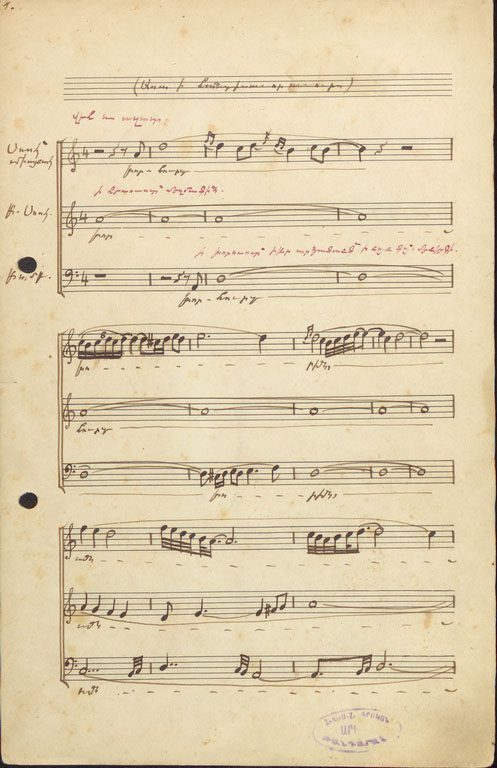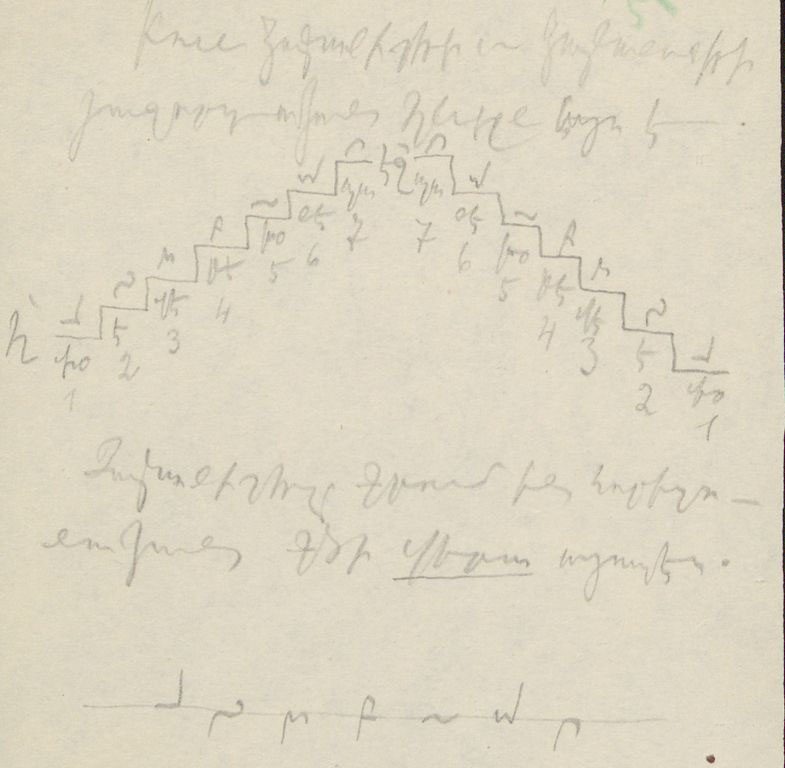COMPOSER
Komitas is the founder of Armenian national art music. Based on the experience of the Western European classical harmony and the achievements of the Armenian composers and exploring the peculiarities of Armenian traditional music, he established his own style in composition, which is unique within the scope of the music history in general. The harmony and polyphony, as well as the principles of texture in Komitas’s music do not undergo any classification of the commonly accepted musicological definitions.
Komitas’s compositional heritage contains arrangements of Armenian folk and sacred songs and original works, which are not derived from folk source. The works based on folk and sacred music are also considered as compositional works taking into account Komitas’s unique approach and treatment.
Komitas composed mainly in the following genres:
a) Songs with piano accompaniment. Komitas compiled his own ethnographic findings of the masterpieces of the Armenian folk songs for voice and piano. The thematic is miscellaneous: lyrical songs, love songs, joke songs, dance songs etc. Some songs require professional vocal skills for performance, such as ‹‹Անտունի›› (Song of the Exiled Man), ‹‹Կռունկ›› (Crane), ‹‹Ծիրանի ծառ›› (Apricot Tree), etc. The very fact is astonishing: these songs were recorded and transcribed from the peasants; and it means that the Armenian peasant possessed vocal skills gifted by nature. Komitas’s songs, which do not derive from folk source, have such stylistic similarities to folk music that are often considered as folk songs by Armenians. ‹‹Կաքավիկ›› (Partridge) is noteworthy in this context.
b) Choral songs. Komitas’s choral works include the arrangements of Armenian sacred and folk songs, and original compositions. Sacred songs referring to various church feasts, religious holidays and saints of the Armenian Church calendar are among them, such as The Water Blessing Songs, Maundy Thursday etc. Separate fragments of Patarag (the Armenian Divine Liturgy) are also among his sacred songs: ‹‹Հայր մէր›› (Lord’s Prayer), ‹‹Ամէն: Հայր Սուրբ›› (Amen: Holy Father), etc.
Patarag composed for the male choir is the only large-scaled work survived from Komitas. In different periods of his activity Komitas compiled the Armenian traditional chants of Patarag, which is the most important ceremony of the Armenian Church, for various voicing. Komitas mostly picked up the traditional chants of Patarag as transcribed by N. Tashchian, published in 1874 and in 1878 in Etchmiatsin. Komitas also used his own transcriptions of the chants from Patarag, which had survived in oral tradition. Some arrangements of the chants of Patarag by Komitas survived fragmentarily. To be noted is the Patarag of of Nor Jugha (New Julfa) or the Armenians of India, which was first performed in 1910s. There is also a version of Patarag with German translation of the literary texts, which was written in Berlin in 1898-99 by yet student Komitas. Komitas often considered his arrangements of Patarag chants for stage performance. Nowadays, Komitas’s last Patarag, written in 1914, appears both in the concert halls and during the church liturgy.
Folk song arrangements by Komitas are written for various voicing. Folk music has different genres in compliant with rustic life and community activity. The choral arrangements of Komitas embrace different genres: work songs, wedding songs which are also presented in the form of cycles, dance songs and joke songs, ceremonial songs, etc.
c) Piano works. Komitas’s remarkable piano works are «Յոթ պարեր» (Seven Dances) which present arrangements of dances from different regions of Armenia. Komitas’s «Մշո շորոր» (Sway dance of Muş) involves several Armenian dances. The miniatures named «Երգեր» (The Songs) are based on the melodies of the Armenian different folk songs, etc. The piano works have unique style characterized by transparency, delicate colors, and specific devices.
d) Opera projects. Several operatic ideas of Komitas are known, manifestations of which survived merely in sketches and in drafts. Anoush opera based on the poem of the Armenian poet Hovhannes Tumanyan and Sasna Tsrer, based on the Armenian epic poem are among them. The choice of operatic plots comes to witness the significance of the Armenian culture for Komitas.
e) Ensembles and orchestral works created in Komitas’s student life period witness about his mastering of the classical music techniques perfectly. “Walde Nacht” is written for the symphony orchestra. Komitas authors also quartets, quintets and other ensembles written in early creative period. Though these pieces show that he perfectly mastered the techniques of different genres of classical music, however, later he gave preference to vocal, choral and piano music.

Profound Mystery from Patarag (the Divine Liturgy), autograph

1912, Constantinople
ETHNOMUSICOLOGIST, MUSIC COLLECTOR
Komitas led the collection, classification and study of traditional music to an academic level. He is one of the first ethnomusicologists in the world. During his entire conscious life, he regularly traveled to different villages, towns and other dwelling places and collected thousands of traditional songs and melodies. He gave priority to the songs recorded in the remote villages, as the foreign influences were very vague there, and the song was preserved in its pure nature. His work was very hard, as the peasants refused singing the songs out of their real environmental context only for the recording purposes.
Komitas wrote: “The peasants hardly sing or reject singing, if a non-villager asks to sing, for example, a working song while being at home. The folks do not know art singing as so. Each song is created or taught in its place, in its time. No villager will sing a threshing song while sitting at home, because the field is the place for creating and singing a treashing song”. («Հայ գեղջուկ երաժշտութիւն» (The Music of Armenian Peasants, in “Studies and articles”, Book A, p. 377).
Overcoming the on-way impediments, Komitas succeeded to transcribe and, hence, protect from oblivion thousand samples of Armenian traditional music. It includes such masterpieces of Armenian sacred and folk music, as «Մոկաց Միրզա» (Mokats Mirza), the epic songs of David of Sasoun, «Կռունկ» (Crane) and other pilgrim songs, «Լոռվա գութաներգ» (Ploughing Song of Lori) and other work songs, «Տիրամայրն» (Stabat Mater), taghs (ornamented chants) of Grigor Narekatsi (Gregory of Narek, Saint of the Armenian Apostolic Church).

Elementary Theory of Music, Komitas’s textbook, autograph
MUSICOLOGIST
The musicology is one of the crucial spheres of Komitas’s activity. He presented the results of his research to various audiences, including the conferences of the International Music Society. He authored a number of articles presenting the results of his research written in Armenian and German. Based on the results of research on Armenian sacred and folk music, he drew a range of statements and inventions of fundamental significance for the Armenian culture. The following are especially noteworthy:
a)Accentuation of the historical-geographical and social bases of Armenian music development. In Komitas opinion, various factors such as geographical location, climate conditions, language etc. formulate music of a nation.
b)Genre classification.
c)Invention of the Armenian music scales. Komitas revealed that the scales laid in the basis of Armenian music differ from that of Western music in terms of certain unique structural principle.
d)Clarification of structural basis.
e)Research on khaz music notation. Khaz notation is an Armenian medieval music fixation system that evolved in the VIII century and reached its peak in the XII-XV centuries. The notation system was circulated till the XVIII century, and then it was step by step left out of usage. Komitas succeeded to reveal the key to khaz deciphering in the result of research conducted over many years.
f)Komitas was engaged in comparative folkloristics. Exploring music samples of the neighboring nations, including Armenians, Iranians, Kurds, Turks, Arabs, and Assyrians, he clarified the typical features of music of each nation.
PERFORMER
Komitas was a singer and conductor. His vocal and choral performances encountered wide reactions among the audience. There are numerous witnesses about his delightful voice, which “compelled” the audience to tear up with his performance. The singing recordings of Komitas done in Paris, in 1912 are available by now.
TEACHER
Komitas taught at the Gevorgian Seminary in Etchmiatsin, Armenia, and then he gave private music lessons in Constantinople. Komitas was planning to establish a conservatory in Constantinople. Unfortunately, he didn’t manage to accomplish his aim because of the Armenian Genocide in Ottoman Empire; however, he managed to enlighten young and gifted generation, and some of them had significant role in the field of Armenian music later. From the disciples of Komitas, Barsegh Kanachyan (1885-1967) became a composer, Vardan Sargsyan (1892-1978) was a musician also to disseminate Komitas’s compositions, and Mihran Toumajan (1890-1973) maintained Komitas’s engagement in ethnography.